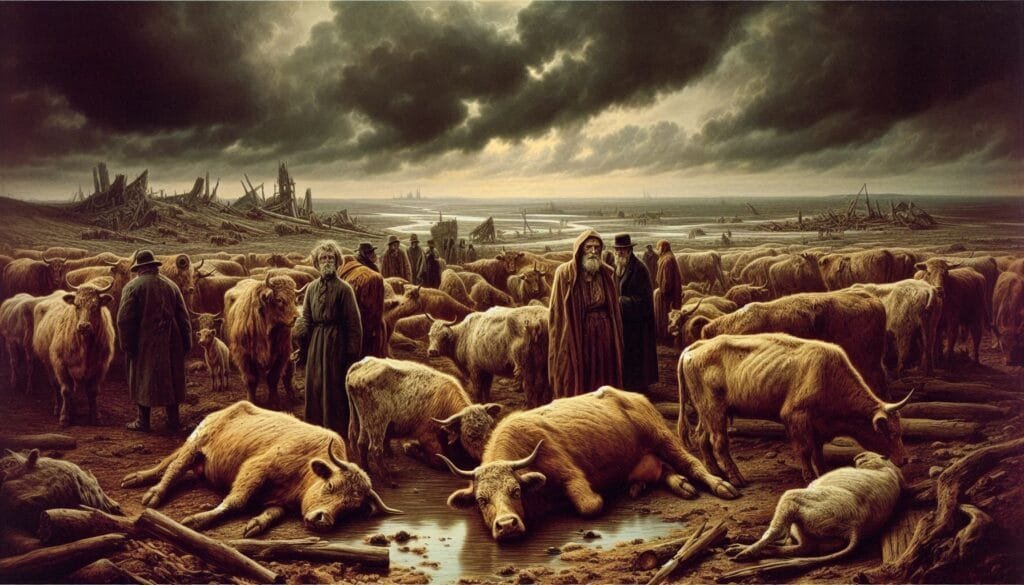Rinderpest Eradication in India

Introduction to Rinderpest and Its Impact on Indian Agriculture
India’s agricultural sector has long been under threat from various diseases that affect farm animals. Among the most devastating diseases was rinderpest, a viral disease that primarily impacted cattle. The widespread infection led to large-scale mortality rates in livestock, which in turn affected farmers’ livelihoods and the country’s overall agricultural output.
The vaccination against rinderpest became a game-changer in saving livestock and improving the productivity of the farming community in India.
Rinderpest, often referred to as cattle plague, is a highly contagious viral infection that primarily affects cattle, buffalo, and other cloven-hoofed animals. Before the vaccine, it led to devastating losses, which caused significant economic hardship for farmers and the country as a whole.
However, through a determined vaccination program, India succeeded in eliminating this disease, marking a significant milestone in animal health.
The Devastation of Rinderpest in India
Rinderpest was one of the deadliest diseases for livestock, resulting in mortality rates as high as 90%. The disease caused fever, diarrhea, and severe respiratory symptoms in infected cattle, leading to rapid death in many cases. The economic loss was substantial as cattle were the primary source of income for many farmers. The loss of cattle meant reduced milk production, fewer draught animals for farming, and a decrease in meat supplies.
Farmers in India, especially in rural areas, depended heavily on cattle for their livelihoods. Therefore, the spread of rinderpest posed a serious threat to food security and agricultural productivity.
Vaccination Campaign: The Turning Point
India’s journey to combat rinderpest began with the introduction of vaccination programs in the 1980s. The government of India, in collaboration with international organizations like the Food and Agriculture Organization (FAO) and the World Organisation for Animal Health (OIE), launched a nationwide vaccination drive to control the spread of the virus. This drive helped protect millions of cattle and other livestock from the disease.
The successful vaccination efforts included a combination of mass immunization campaigns and targeted vaccination in high-risk areas. As a result, the incidence of rinderpest in India drastically declined, and eventually, the country achieved rinderpest eradication in 2011.
For more information on vaccination efforts in India, visit the FAO website.
The Role of Vaccination in Eradicating Rinderpest
Vaccination plays a critical role in controlling viral diseases, and rinderpest was no exception. The vaccine used for rinderpest was a live attenuated virus vaccine, which was highly effective in preventing the disease. This vaccine provided immunity against the virus, reducing the number of cattle infections and preventing outbreaks.
India’s large-scale vaccination campaigns targeted not only rural farmers but also remote areas where livestock health had previously been a neglected issue. The country’s success in the battle against rinderpest demonstrated the effectiveness of vaccination in controlling animal diseases. The government’s efforts were accompanied by public awareness campaigns, training for veterinarians, and better surveillance of cattle health.
Impact on Indian Agriculture
The eradication of rinderpest had a profound effect on India’s agricultural sector. By saving millions of cattle from disease, the country was able to stabilize its livestock population. This stabilization was crucial for increasing milk production, improving beef supplies, and enhancing the overall productivity of the agricultural sector.
India’s dairy industry, in particular, saw significant benefits from the reduction in rinderpest cases. As the health of cattle improved, milk yields per cow increased, which had a positive effect on the income of dairy farmers.
For a deeper understanding of the relationship between livestock health and agricultural productivity, refer to this article on agriculture and livestock health.
Challenges Faced During the Vaccination Campaign
While the vaccination drive was highly successful, it was not without its challenges. One of the major obstacles was reaching remote areas with limited infrastructure. Many rural areas lacked access to veterinary services, and convincing farmers to adopt new vaccination practices required extensive outreach and education.
Moreover, the sheer scale of the vaccination program meant that a significant amount of resources were required. The government had to invest in producing enough vaccines, organizing transportation, and ensuring that vaccinations were administered in a timely manner. Despite these challenges, India’s efforts proved successful, and the country was able to eliminate rinderpest.
Global Significance of Rinderpest Eradication
India’s achievement in eradicating rinderpest holds global significance. It was a landmark victory in the fight against animal diseases and placed India at the forefront of disease control efforts worldwide. The success of India’s vaccination program was an inspiration for other countries struggling with similar challenges.
The eradication of rinderpest is considered a major milestone in global animal health, especially since rinderpest was one of the few diseases to be completely eradicated in both animals and humans. India’s experience provides a model for how countries can successfully combat and eliminate diseases that threaten animal health and agricultural productivity.
For more information on the global efforts to eradicate rinderpest, refer to the World Health Organization (WHO) website.
Future of Livestock Health in India
With the eradication of rinderpest, India has made significant strides in improving the health of its livestock. The success of vaccination programs has paved the way for ongoing efforts to combat other livestock diseases. India is now focused on improving its veterinary infrastructure, enhancing disease surveillance, and introducing new vaccines for other viral and bacterial diseases.
India continues to invest in veterinary education, ensuring that veterinarians are well-equipped to handle emerging animal diseases. By learning from the experience of rinderpest eradication, the country aims to maintain a healthy livestock population and ensure the continued success of its agricultural sector.
Conclusion
The eradication of rinderpest in India is a shining example of what can be achieved when governments, organizations, and farmers work together. The success of vaccination programs not only saved millions of cattle but also ensured better agricultural productivity, improved food security, and more sustainable farming practices.
India’s ongoing commitment to animal health is key to securing its agricultural future and improving the livelihoods of millions of farmers across the country.
More From Animal Diseases:
Colic in Horses






Responses